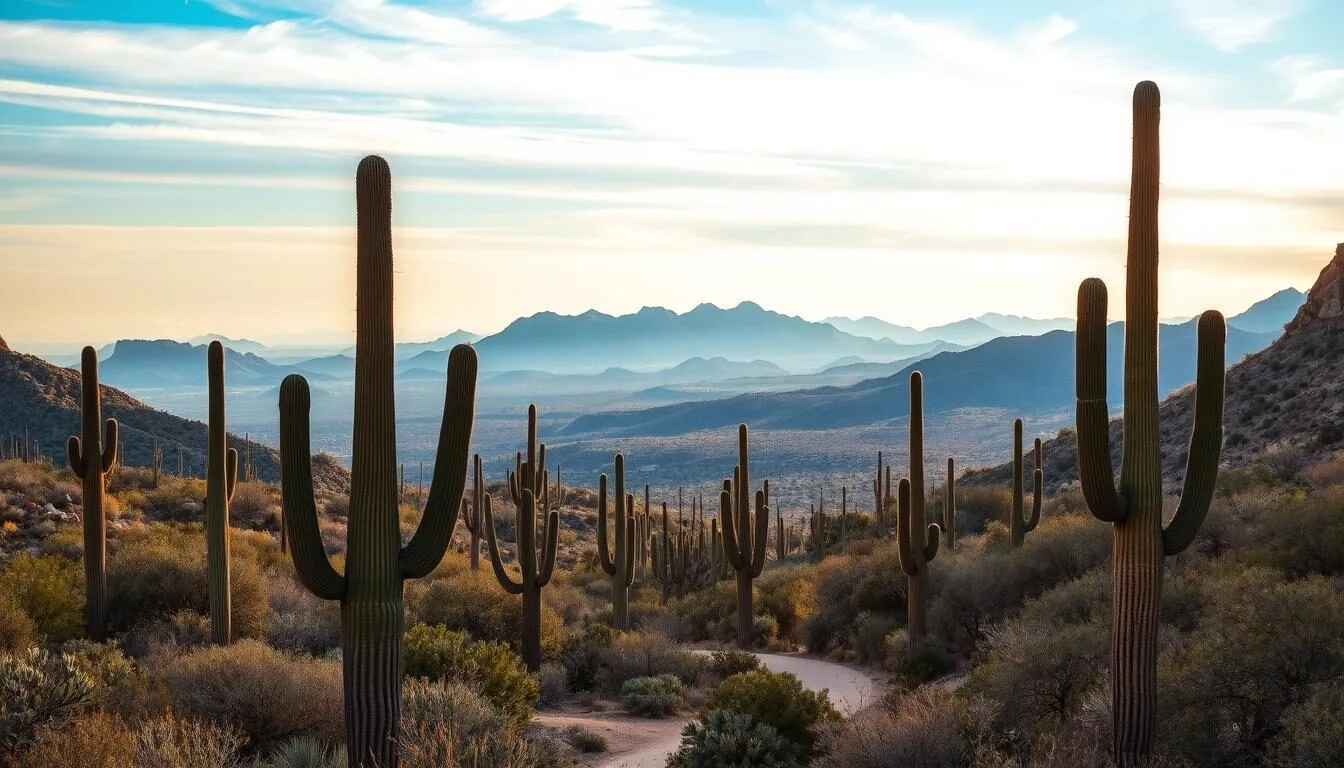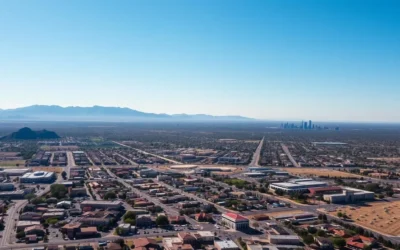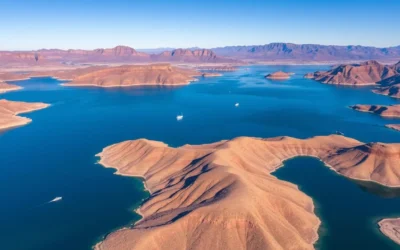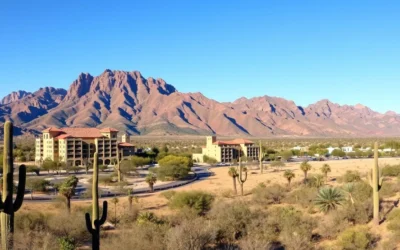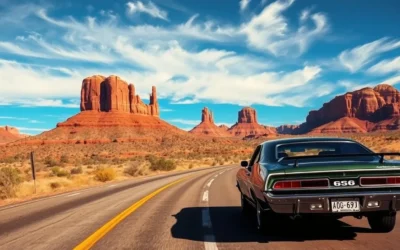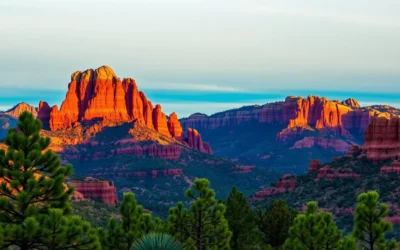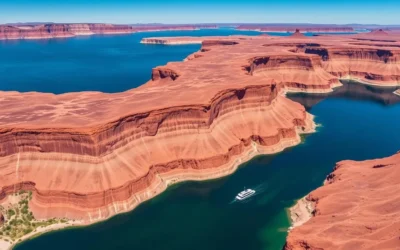✓ Accommodations✓ Flights✓ Rental Cars✓ Tours & Activities
You’ve likely heard that Tucson is a hidden gem in the American Southwest, but did you know that it’s home to a staggering 300+ days of sunshine per year? This vibrant desert city is a perfect blend of natural wonders, rich history, and cultural attractions, making it an ideal destination for both day trips and weekend getaways.
As the second-largest city in Arizona, Tucson boasts a unique character shaped by the Sonoran Desert. You’ll discover a diverse range of experiences, from exploring the breathtaking Saguaro National Park to savoring the local cuisine in a city that’s been designated as a UNESCO City of Gastronomy.
This guide will take you through the best things to do in Tucson, showcasing the top attractions and experiences that make this desert oasis a must-visit destination.
Discover the Desert Wonders of Tucson
The Sonoran Desert, with its rich biodiversity, sets the stage for an unforgettable experience in Tucson. As you explore this unique landscape, you’ll encounter a world of fascinating flora and fauna.
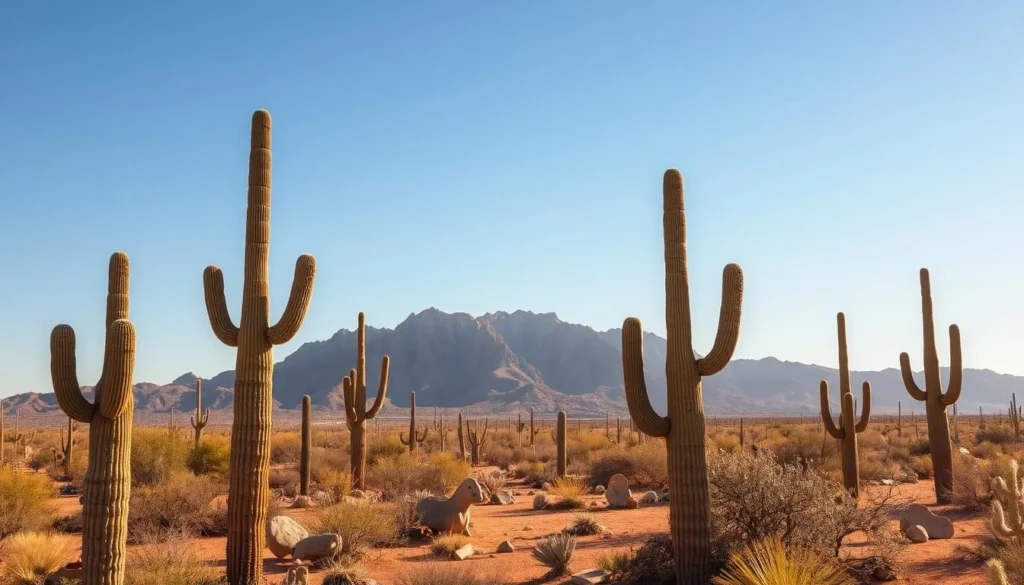
The Unique Sonoran Desert Landscape
The Sonoran Desert surrounding Tucson is characterized by its incredible variety of life, with over 200 species of desert animals and more than 1,000 types of plants. The iconic saguaro cactus, a symbol of the American West, is a prominent feature of this landscape. The desert environment has not only shaped the natural beauty of Tucson but has also influenced the city’s development, architecture, and cultural identity.
The contrast between the desert terrain and the nearby “sky islands” of mountain ranges adds to the region’s dramatic beauty. Visitors can enjoy stunning desert sunsets and exceptional stargazing opportunities due to the clear desert skies.
When to Visit Tucson for the Best Experience
Tucson is a year-round destination, but the best times to visit are during the spring and winter months. Spring brings a spectacular display of wildflowers, while winters offer mild temperatures ideal for outdoor activities. Summers can be extremely hot, so visitors should be prepared for high temperatures.
| Season | Weather | Activities |
|---|---|---|
| Spring | Mild temperatures, wildflowers | Hiking, wildflower viewing |
| Summer | Hot temperatures | Early morning or evening outdoor activities |
| Winter | Mild temperatures | Hiking, biking, stargazing |
Regardless of when you visit, it’s essential to stay hydrated and be mindful of desert safety. With its unique landscape and pleasant winter weather, Tucson offers a desert experience like no other in the world.
Explore Saguaro National Park
![]()
With its stunning landscapes and iconic saguaro cacti, Saguaro National Park is a treasure trove of natural wonders. Spanning 143 square miles, the park is divided into two districts: East and West.
East and West Districts: What to Know
The West district is the most popular due to its proximity to I-10, making it easily accessible. While both districts offer similar desert landscapes, they provide distinct experiences. The East district is known for its scenic drives and less crowded trails.
Best Hiking Trails and Scenic Drives
Saguaro National Park offers numerous hiking trails for all skill levels. The Hugh Norris Trail in the West district is a challenging hike with rewarding views. For a more leisurely experience, the Valley View Overlook Trail is a great option. Scenic drives, such as Bajada Loop Drive, offer breathtaking views of the surrounding landscape.
Fascinating Facts About Saguaro Cacti
Saguaro cacti are slow-growing giants. They don’t produce flowers until they’re about 35 years old, and their first branches appear between 50-70 years. With an average lifespan of 150-175 years, these cacti are a testament to the enduring beauty of nature.
Whether you’re hiking, driving, or simply taking in the views, Saguaro National Park is a must-visit destination. Plan your visit from sunrise to sunset, and don’t forget your camera to capture the stunning sunsets.
Visit the Arizona-Sonora Desert Museum
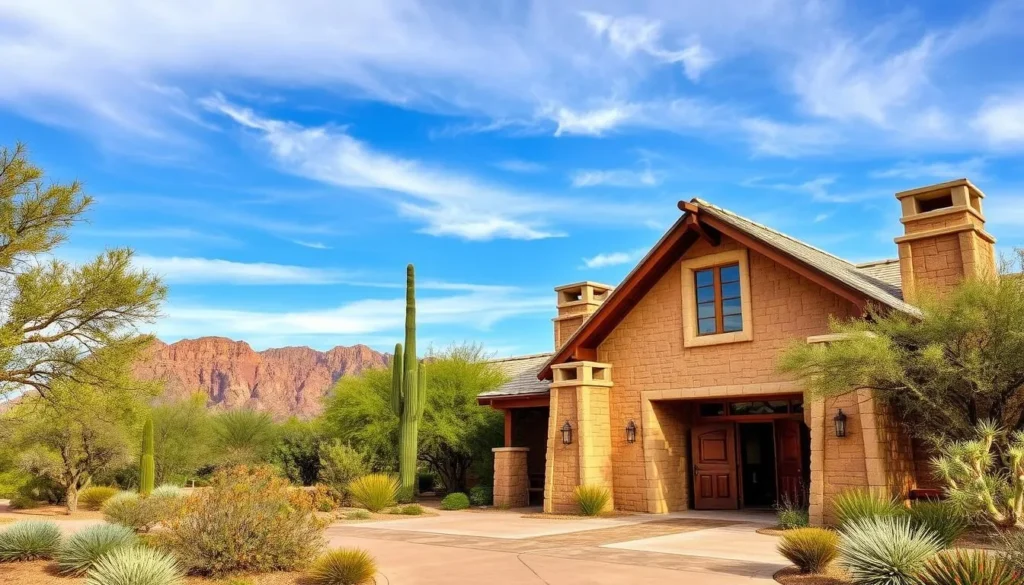
With its unique blend of zoo, botanical garden, aquarium, and natural history museum, the Arizona-Sonora Desert Museum is a standout destination. Located only a few minutes from the west entrance of Saguaro National Park, this 98-acre outdoor museum provides a comprehensive experience of the region’s unique desert ecosystem, including the desert wildlife and native plants.
Wildlife Exhibits and Gardens
The Arizona-Sonora Desert Museum is home to a variety of wildlife exhibits that showcase the region’s diverse fauna. At Cat Canyon, you’ll see bobcats, ocelots, and foxes in a natural setting. The Mountain Woodland habitat is where you can find mountain lions, mule deer, and even black bears. The Reptile, Amphibian, and Invertebrate Hall features a variety of reptiles in a climate-controlled environment. Additionally, the Hummingbird Aviary and Warden Aquarium are must-see attractions within the museum.
The museum’s grounds are also beautifully landscaped with manicured desert gardens, offering expansive views and a chance to appreciate the native plants up close.
Educational Programs and Activities
The Arizona-Sonora Desert Museum offers a range of educational programs, including guided tours, demonstrations, and hands-on activities for visitors of all ages. These programs provide a deeper understanding of the Sonoran Desert ecosystem and the museum’s role in conservation efforts and research.
Visitors can enhance their experience by participating in these educational activities, making the Arizona-Sonora Desert Museum an ideal destination for families and nature enthusiasts alike.
Experience Tucson’s Rich Cultural Heritage
Immerse yourself in Tucson’s vibrant cultural scene, where history and community come alive. Tucson’s rich cultural heritage is reflected in its historic landmarks, cultural events, and traditional architecture.
San Xavier del Bac Mission: The White Dove of the Desert
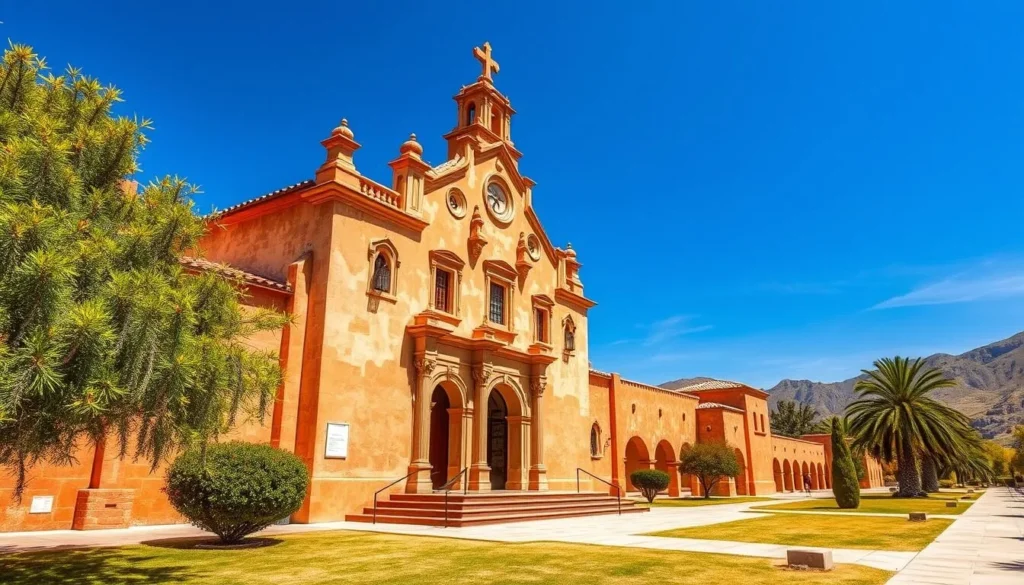
The San Xavier del Bac Mission is a national historic landmark located on the Tohono O’odham Indian Reservation. Constructed between 1783 and 1797, it is considered the oldest intact European structure in Arizona. This beautifully preserved Spanish colonial mission is nicknamed the “White Dove of the Desert” and features stunning Baroque architecture and impressive religious art.
Barrio Viejo: Colorful Adobe Architecture
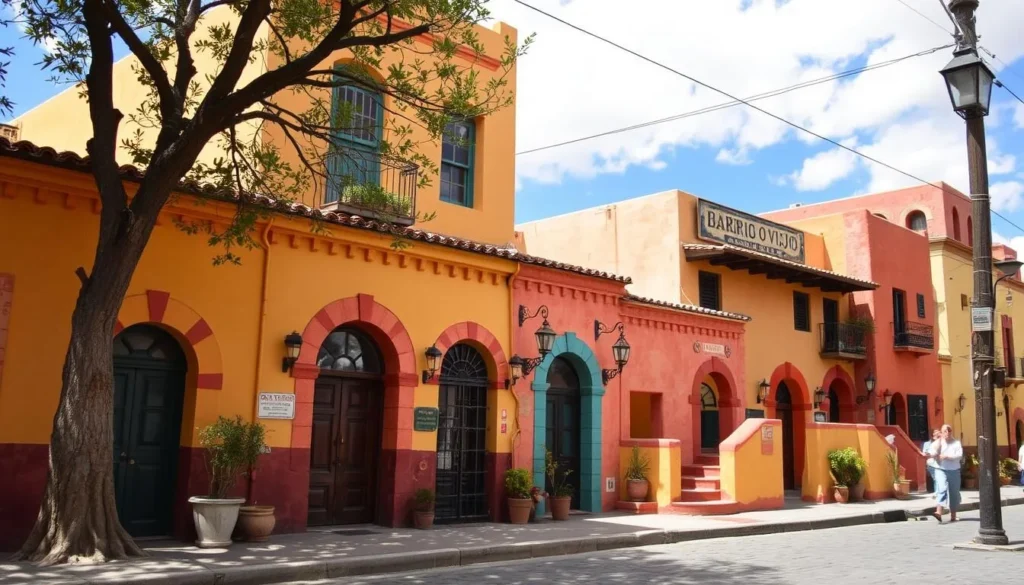
Barrio Viejo, which translates to the “old neighborhood,” is the historic heart of Tucson. This vibrant neighborhood is known for its colorful adobe homes, many of which date back to the 19th century. Barrio Viejo reflects Tucson’s multicultural heritage, having been home to a diverse community of Mexicans and immigrants from around the world.
Tucson’s cultural heritage is a unique blend of Native American, Spanish, Mexican, and American influences. Visiting these cultural landmarks provides a glimpse into the city’s rich history and its significance as a crossroads of cultures.
Tucson, Arizona: Best Things to Do for Outdoor Enthusiasts
Outdoor enthusiasts flock to Tucson for its unique blend of desert and mountain activities, making it an ideal destination for adventure seekers. Whether you’re looking to hike, climb, or simply take in the breathtaking views, Tucson has something for everyone.
Hiking Picacho Peak
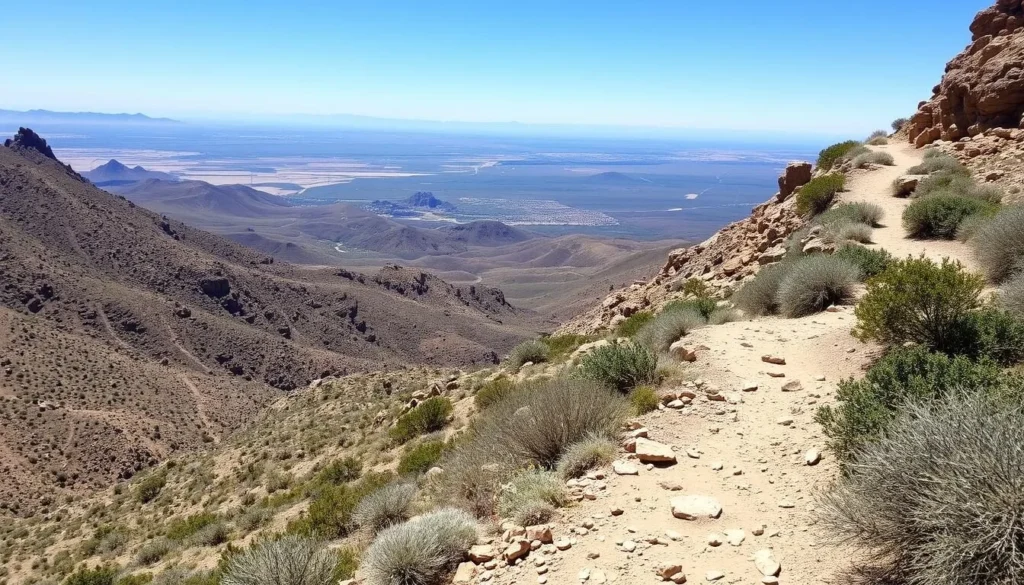
The Hunter Trail to Picacho Peak is a 2.8-mile challenging hike that offers adrenaline-pumping cable climbs, sheer cliffs, and narrow ridges. To tackle this trail, it’s recommended to bring gloves for the cables and to check the park hours and admission fees beforehand. The best seasons to visit are from October to April when the weather is cooler.
The spectacular views from the summit make the strenuous climb worth the effort. On a clear day, you can see for miles in every direction, taking in the vast expanse of the Sonoran Desert.
Mount Lemmon Adventures

Mount Lemmon, the highest point in the Santa Catalina Mountains at over 9,000 feet, offers a dramatic change in climate from the desert below to an alpine forest. Visitors can enjoy a variety of activities throughout the year, including winter skiing, summer hiking, rock climbing, and camping.
The Mount Lemmon Scenic Byway, also known as the Catalina Highway, is one of Arizona’s most beautiful drives, offering dramatic views and distinct ecological zones. Whether you’re looking for a leisurely drive or an action-packed adventure, Mount Lemmon has something to offer.
For outdoor enthusiasts, Tucson is an ideal destination for a multi-day adventure. You can combine hiking Picacho Peak, exploring Mount Lemmon, and visiting other natural attractions around Tucson for a trip that’s both exciting and memorable.
Unique Attractions You Won’t Find Elsewhere
For those seeking something different, Tucson offers a couple of extraordinary attractions that stand out from the rest. You can explore the fascinating world of ecological systems and aviation at two of Tucson’s most unique sites.
Biosphere2: Earth Science in Action
Biosphere2 is a 3-acre facility that was originally constructed between 1987-1991 as a $150 million science experiment to test self-sustained ecological systems for space colonization. Eight people lived inside the dome for two years, maintaining a self-sustained lifestyle with 1,000 species of plants and animals. Now, operated by the University of Arizona since 2007, it serves as an earth science research facility. The site contains seven distinct biomes: rainforest, ocean with coral reef, mangrove wetlands, savannah grassland, fog desert, agricultural system, and human habitat.
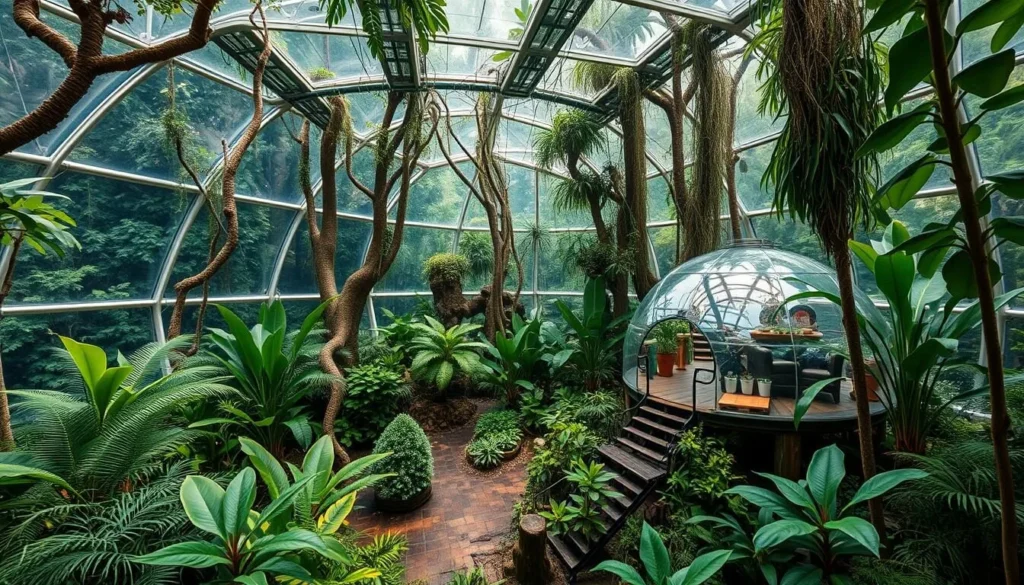
Pima Air & Space Museum
The Pima Air & Space Museum is one of the world’s largest aviation museums, spanning 80 acres and housing over 350 aircraft. You can explore a vast collection ranging from vintage planes to iconic military jets, including the Pima Air & Space collection that features everything from the world’s smallest aircraft to the massive 787 Dreamliner. A 45-minute narrated tram tour is available, and you can explore inside some of the aircraft.

Both Biosphere2 and the Pima Air & Space Museum offer unique experiences that make Tucson stand out. Be sure to check the hours, admission fees, and plan your visit accordingly to make the most of your time at these attractions.
Family-Friendly Activities in Tucson
Families traveling to Tucson will discover a treasure trove of fun and educational experiences. From world-class zoos to historic theme parks, there’s something for every child to enjoy.
Reid Park Zoo
Reid Park Zoo is a 20-acre facility home to over 500 species of animals, divided into four distinct zones. The zoo is renowned for its excellent veterinary care and community support, making it a beloved institution in Tucson.
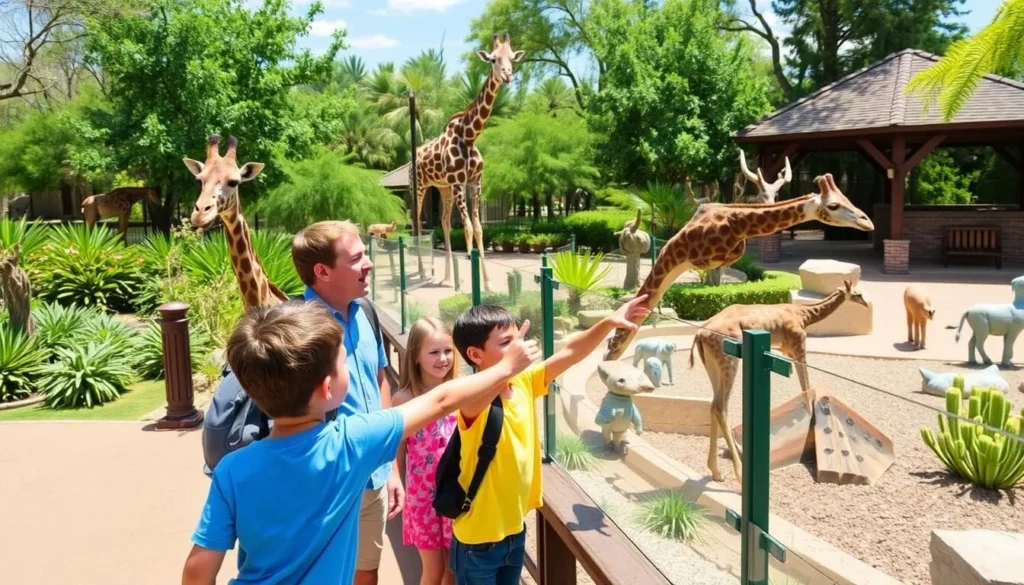
Old Tucson Studios
Step back in time at Old Tucson Studios, a historic theme park built in the 1950s as a filming location for famous Western movies and TV shows like “Little House on the Prairie” and “Gunfight at the O.K. Corral.” Today, visitors can enjoy live-action performances, including gunfights and stunts.
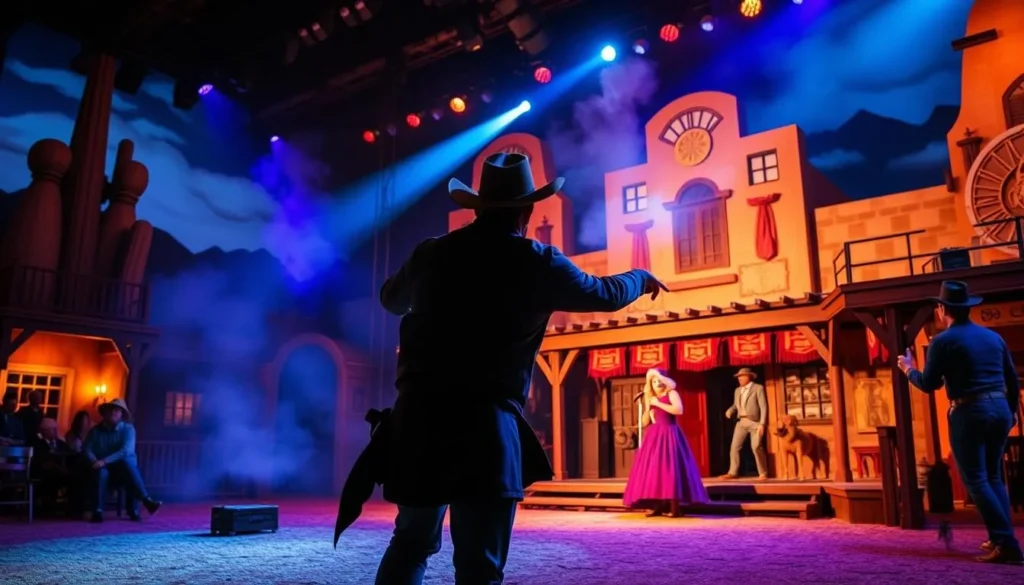
In addition to Reid Park Zoo and Old Tucson Studios, Tucson offers other family-friendly attractions like the Children’s Museum of Tucson and the Museum of Miniatures. When planning your trip, consider combining these attractions for a perfect family day out in Tucson.
Culinary Delights: Tucson’s Food Scene
Tucson, Arizona, is a food lover’s paradise, boasting a rich culinary scene that blends tradition with innovation. As the first United Nations designated City of Gastronomy in the US, Tucson’s restaurants adhere to UNESCO standards, including locally sourcing ingredients and showcasing the region’s indigenous foods with a unique twist.
Mercado San Agustin: A Food Lover’s Paradise
Mercado San Agustin is a modern food hall and open-air market filled with local artisans selling handcrafted goods, delicious food vendors, and live entertainment. You’ll find authentic Mexican dishes at eateries like Seis Kitchen and delicious Mexican Pan Dulce at La Estrella Bakery.

Best Mexican Restaurants in Tucson
Tucson is renowned for its “Best 23 Miles of Mexican food in the US.” Some standout Mexican restaurants include El Guero Canelo, a winner of the James Beard Foundation’s “America’s Classics Award” for its Sonoran hot dogs. Other notable dining establishments are The Parish, Barrio Bread, Mi Nidito, and Downtown Kitchen + Cocktails, each offering a unique taste of Tucson’s culinary identity.
The influence of Sonoran Desert ingredients and indigenous food traditions is evident in Tucson’s unique culinary identity. For a comprehensive culinary experience, explore the city’s high-end restaurants, food trucks, and local markets.
Day Trips from Tucson
When you’re ready to explore beyond Tucson, Arizona, you’ll find plenty of exciting day trip options. The surrounding region is rich in natural beauty, history, and culture, making it an ideal place to experience the best of Arizona.
Kitt Peak National Observatory
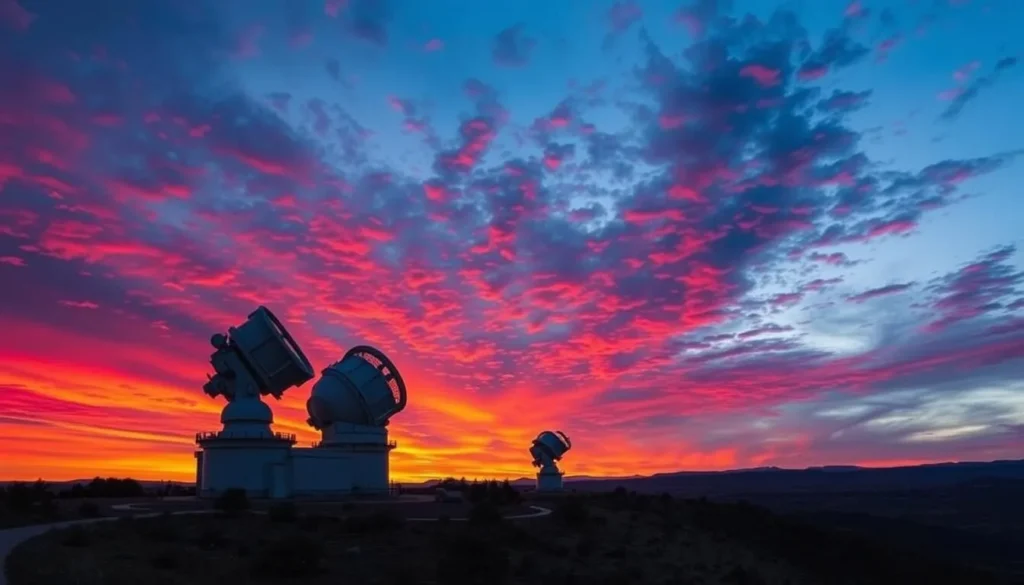
Kitt Peak National Observatory is a must-visit for astronomy enthusiasts. Located in the Quinlan Mountains, it boasts the largest and most diverse collection of astronomical equipment in the world, with 24 telescopes. You can choose between day tours, which focus on the history and equipment of the observatory, or night tours, which offer stargazing opportunities through the telescopes.
Tombstone and Other Nearby Ghost Towns
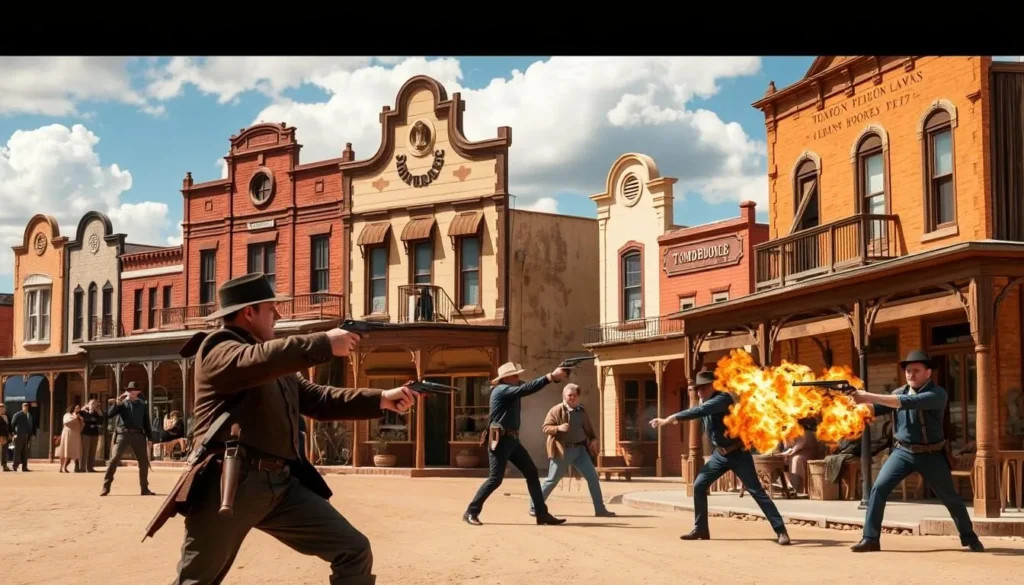
Just outside Tucson lies the historic town of Tombstone, once a booming silver mining area and a notorious “wild west” location. You can explore the preserved 19th-century architecture, visit the famous O.K. Corral, and experience the town’s gunslinger past. Other nearby ghost towns worth visiting include Bisbee, known for its unique art scene and historic mining tunnels.
Hidden Gems Off the Beaten Path
Tucked away in the Arizona desert are some truly unique gems waiting to be discovered. If you’re looking for a more serene experience, consider visiting some of Tucson’s lesser-known attractions.
Life Under the Oaks Lavender Farm
You’ll find a surprising desert oasis at the Life Under the Oaks Lavender Farm, just outside of Tucson. This small family-owned farm is surrounded by ancient oak trees and offers a tranquil escape. Visitors can stroll through the fragrant lavender rows and enjoy the whimsical displays.
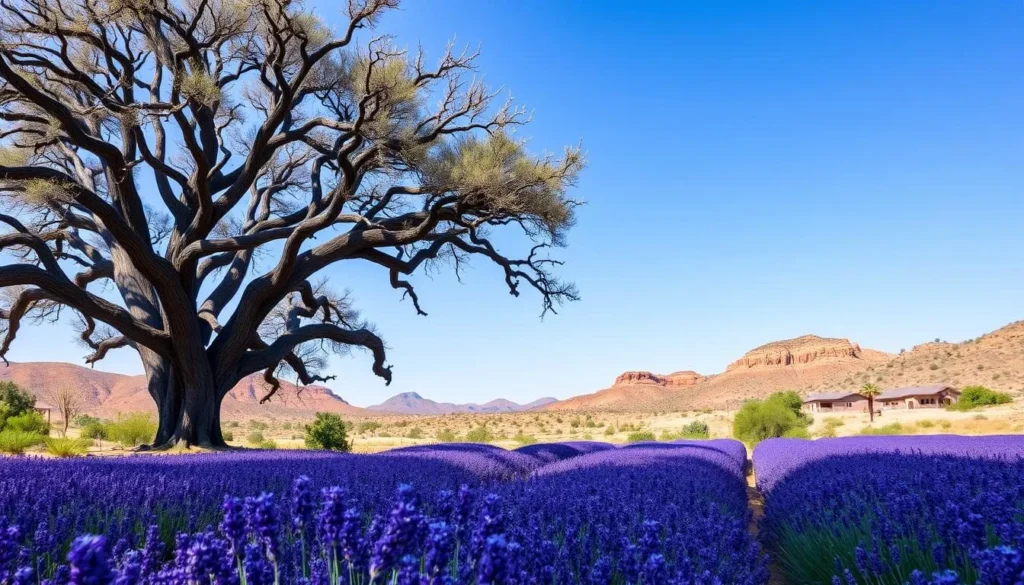
Tohono Chul Park
Tohono Chul Park, meaning “Desert Corner” in the Tohono O’odham language, is a haven for nature lovers. The park features botanical gardens, a riparian habitat, and discovery trails, all set against the stunning backdrop of the Santa Catalina Mountains. It’s a great place to learn about the Sonoran Desert Region’s unique ecosystem.
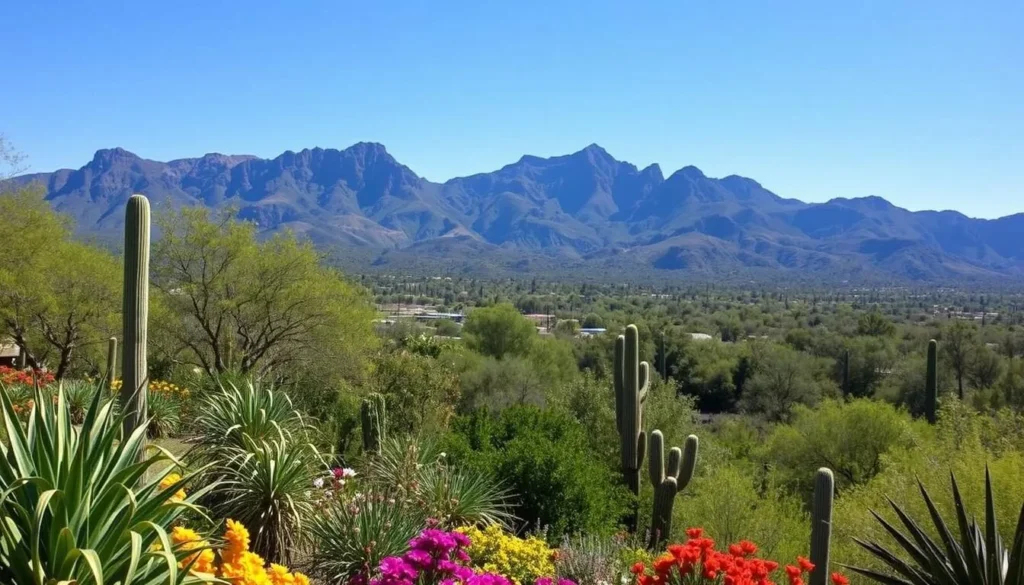
Other hidden gems around Tucson include Oracle State Park, Agua Caliente Regional Park, and Madera Canyon. These attractions offer a range of outdoor activities and breathtaking natural beauty, making them perfect for your next adventure.
Conclusion: Planning Your Perfect Tucson Adventure
Tucson, Arizona, is a hidden gem waiting to be explored, with its unique blend of desert landscapes, cultural attractions, and exciting activities. As you plan your trip, consider the diverse attractions that make Tucson a standout destination in the United States, from the breathtaking Saguaro National Park to the vibrant cultural scene.
Whether you’re looking for a weekend getaway or a week-long exploration, Tucson has something for everyone. Be sure to visit during the optimal season, and don’t miss the opportunity to experience the city’s growing craft beer scene, rich history, and delicious restaurants. As you explore this desert city, remember to respect the natural environment and cultural sites, and discover the authentic character of Tucson beyond the typical tourist attractions.
The above is subject to change.
Check back often to TRAVEL.COM for the latest travel tips and deals.
